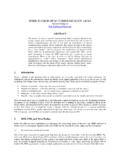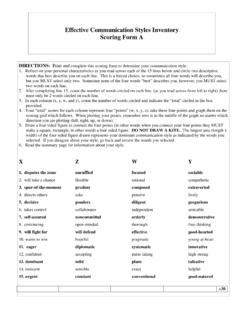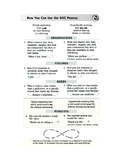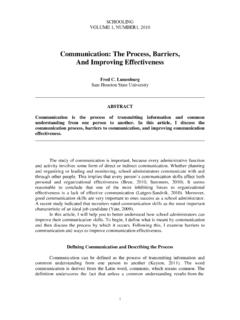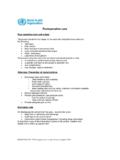Transcription of Effective Communication in
1 1 Central Coast Children s Foundation Augmentative Communication Inc. Rehabilitation Engineering Research Center on Communication Enhancement (AAC-RERC) Available as free download Effective Communication in Children s Hospitals A Handbook of Resources for Parents, Patients, and Practitioners Effective Communication in Children s Hospitals: A Handbook of Resources for Parents, Patients, and Practitioners 2 This handbook had its origins in an article that Sarah Blackstone and Harvey Pressman wrote for the November 2011 issue of Brainchild, the official publication of the Hong Kong Society of Child Neurology and Developmental Pediatrics. The article, entitled Communication Enhancement in Children s Hospitals: Practical Tools to Support Communication Vulnerable Patients, ended with a section ( Summary and Available Resources ) directing the reader to our Patient-Provider website to find multiple resources and references to many of the tools, forms, Communication boards and strategies that have proven their value in the field , and to find the most useful resources and references.
2 This handbook is designed not only to provide those available resources, but also to assemble a growing collection of materials that, with periodic updates, may prove of value to others dealing with issues of Communication vulnerability in children s hospitals. We hope it proves helpful to our readers, and welcome your suggestions for additions to future editions. Sarah Blackstone and Harvey Pressman Effective Communication in Children s Hospitals: A Handbook of Resources for Parents, Patients, and Practitioners 3 Table of Contents INTRODUCTION page 4 ARTICLES AVAILABLE ONLINE page 6 POWERPOINT PRESENTATIONS page 6 WEBCASTS AND VIDEOS page 12 MATERIALS FOR PATIENTS, PROVIDERS AND FAMILY MEMBERS page 13 BEDSIDE MESSAGES page 14 TALKING PHOTO ALBUM STRATEGIES page 28 APPS for Communication IN A HOSPITAL SETTING page 32 APPS FOR DIVERSION IN A HOSPITAL SETTING page 40 Effective Communication in Children s Hospitals: A Handbook of Resources for Parents, Patients, and Practitioners 4 Children's hospitals face unique challenges when they try to make practical improvements in their Communication with children and family members.
3 Effective Communication is more crucial, and often more complicated, than it is with adult patients. There are valuable techniques, tools, strategies that healthcare providers can utilize to communicate more effectively with even the youngest children who are admitted for treatment to hospitals, as well as with the family members who accompany them. While available resources and relevant literature are still quite limited, it is important to be aware of an article like the one recently published by John Costello and colleagues focusing on Augmentative and Alternative Communication (AAC) in the Pediatric Intensive Care Unit and published in a special, AAC-focused 2010 issue of the Journal of Pediatric Rehabilitation Medicine (Costello, Patak & Pritchard 2010). The article is important not only because it provides concrete case studies, but also because it delineates phases of treatment that can help hospital staff avoid dangerous Communication breakdowns and remove barriers to Effective patient-provider Communication .
4 Costello works at Children s Hospital Boston, which is preeminent among American children s hospitals in finding creative new solutions that improve Communication between patients/families and providers, in the quality of health care and in the satisfaction of patients and their families with medical encounters. Communication specialists at Boston Children s have shared their insights and discoveries through many peer-reviewed articles, PowerPoint presentations, webcasts, videos, hospital Communication boards, and the like. In addition to the above-mentioned article, other valuable resources on Boston Children s website include information about the EZ Picture Communication Board pre-operation voice banking (Costello 2000), implementing the assessment of patient Communication needs into routine care (Costello, Patak & Pritchard 2010), providing Communication support to children with cortical vision impairments (Costello 2011), and on how augmentative Communication can support children facing end of life.
5 All are described in more detail in this publication. Another uniquely valuable resource is a set of Bedside Message Materials that enable hospitalized children with impaired speech to communicate some basic needs to nurses and other hospital staff. These materials include a laminated Communication board with a list of key bedside messages on the reverse, and a talking photo album that both illustrates and speaks the messages researchers in Australia report are the most important messages nurses and patients need for Communication . (Section III shows an example in English and Mandarin Chinese.) The messages are now available in 20 different languages. Some hospitals prepare children and their families for their stay in an effort to reduce stress and anxiety associated with hospital stays. I ntroduction Effective Communication in Children s Hospitals: A Handbook of Resources for Parents, Patients, and Practitioners 5 [For example, a special Emergency Room Communication Kit is now available in every French hospital.]
6 Professionals in France are demonstrating leadership in Emergency Rooms. ] Also, Sparadrap, a French organization founded in 1993, provides valuable information for children, parents, and health professionals to support understanding of specific procedures, treatments, et al., Its website, available in French and English, has age-appropriate materials for children, parents and professionals, such as: For Children a picture dictionary of medical terms with simple definitions for diseases, instruments, medicines, and other health-related items; a section on various kinds of injections, with images, videos, quizzes and simple texts walking children through the process; a place where kids can post their stories or messages about their experiences. For Parents an advice page, covering topics such as how to explain to kids what will happen in the hospital and how to comfort their children.
7 For Professionals a list of training sessions and workshops on topics like how to communicate with children in the hospital, how to use puppets to engage children, and how to reassure children. - advice on topics such as assessment, anxieties and photo albums. In the United States, the Children s Hospital of Philadelphia (CHOP) offers many activities, programs and preparations for children before, during and after a hospitalization. Beforehand, children can check out the Kids Health Galaxy, a website that prepares children for surgery using games. The Kids Health Galaxy is medically-reviewed and teaches kids about what to expect in a hospital. There are animated tours of facilities, introduction to personnel, and walk-throughs of procedures ( , blood tests, X-rays, IVs and catheters). Games, like memory and quizzes reinforce the concepts. There is even a section with printout sheets that kids can bring to the hospital and color.
8 CHOP also provides tips for parents, giving age-appropriate strategies to help parents prepare children for a medical encounter. For instance, CHOP suggests using soothing music to help infants and toddlers cope, and letting adolescents play with hand-held video games while in the hospital. During the hospital stay, CHOP offers children and young adults ways to decrease their boredom and alleviate pain and stress. CHOP has a Child Life staff for all inpatient and most outpatient areas. The Paw Partners program brings in dogs to play with the kids. CHOP also encourages art and music therapy, and has an in-hospital school program for kids so they can keep up with their studies. These are a few examples of how hospitals are helping children and families navigate through the pediatric hospital experience. The next sections highlight more references and resources, as well as summary of articles, presentations and specific examples of materials aimed at enhancing Communication and thus, the hospital experience for children and their families.
9 Effective Communication in Children s Hospitals: A Handbook of Resources for Parents, Patients, and Practitioners 6 Beukelman, David, and Ray, Paula. (2010). Communication Supports in Pediatric Rehabilitation. Journal of Pediatric Rehabilitation Medicine, 3, 279 288. Available at: Children with complex Communication needs (CCN) who cannot communicate by natural speech alone have the same social, emotional or physical needs as other children. Communication supports, also known as augmentative and alternative Communication (AAC), help these children express themselves in ways that extend beyond basic needs, such as I m hungry. The authors present several examples of how to provide Communication supports in a pediatric setting, as well as advice for how parents can better serve their children s needs. Blackstone, Sarah. (2010). Communication Access for Children: The Role of Augmentative and Alternative Communication Technologies and Strategies in Pediatric Rehabilitation.
10 Journal of Pediatric Rehabilitation Medicine: An Interdisciplinary Approach, 3, 247-250. Available at: This article presents a brief overview of a recent issue of the Journal of Pediatric Rehabilitation Medicine on Communication . Written by members of the Rehabilitation Engineering Research Center on Communication Enhancement, the issues focuses on ways that augmentative and alternative Communication (AAC) strategies, technologies, and resources can support young people with severe Communication challenges across healthcare environments, in their homes and within their communities. From a policy as well as a practical perspective, the issue raises awareness of new standards and regulations in the United States that recognize the need for Effective patient-provider Communication to improve patient safety, patient outcomes and reduce healthcare costs.







